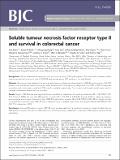| dc.contributor.author | Babic, Ana | en_US |
| dc.contributor.author | Shah, Sonali M | en_US |
| dc.contributor.author | Song, Mingyang | en_US |
| dc.contributor.author | Wu, Kana | en_US |
| dc.contributor.author | Meyerhardt, Jeffrey A | en_US |
| dc.contributor.author | Ogino, Shuji | en_US |
| dc.contributor.author | Yuan, Chen | en_US |
| dc.contributor.author | Giovannucci, Edward L | en_US |
| dc.contributor.author | Chan, Andrew T | en_US |
| dc.contributor.author | Stampfer, Meir J | en_US |
| dc.contributor.author | Fuchs, Charles S | en_US |
| dc.contributor.author | Ng, Kimmie | en_US |
| dc.date.accessioned | 2017-05-01T19:28:48Z | |
| dc.date.issued | 2016 | en_US |
| dc.identifier.citation | Babic, A., S. M. Shah, M. Song, K. Wu, J. A. Meyerhardt, S. Ogino, C. Yuan, et al. 2016. “Soluble tumour necrosis factor receptor type II and survival in colorectal cancer.” British Journal of Cancer 114 (9): 995-1002. doi:10.1038/bjc.2016.85. http://dx.doi.org/10.1038/bjc.2016.85. | en |
| dc.identifier.issn | | en |
| dc.identifier.uri | http://nrs.harvard.edu/urn-3:HUL.InstRepos:32630718 | |
| dc.description.abstract | Background: Chronic inflammation may play a role in colorectal cancer (CRC) pathogenesis. The relationship between soluble tumour necrosis factor receptor type II (sTNF-RII) and survival among CRC patients is not well defined. Methods: We prospectively evaluated the association between pre-diagnosis plasma levels of sTNF-RII and mortality in 544 CRC patients from the Nurses' Health Study and Health Professionals Follow-Up Study diagnosed from 1990 to 2010. Primary and secondary end points were overall and CRC-specific mortality, respectively. Cox proportional hazards models were used to calculate multivariate hazard ratios for mortality. Results: Higher sTNF-RII levels were significantly associated with increased overall mortality (multivariate HR=1.48, 95% CI 1.02–2.16, P-trend=0.006), but not with CRC-specific mortality (HR=1.23, 95% CI 0.72–2.08, P-trend=0.34). In subgroup analyses, among regular aspirin users, those with higher sTNF-RII levels had an adjusted HR of 0.52 (95% CI 0.20–1.33) for overall mortality compared with those with lower sTNF-RII levels, whereas among nonregular aspirin users the adjusted HR was 2.26 (95% CI 1.23–4.01, P for interaction=0.53). Conclusions: Among CRC patients, higher sTNF-RII levels are associated with a significant increase in overall mortality, but not CRC-specific mortality. The role of inflammation and anti-inflammatory medications in survival of CRC patients warrants further exploration. | en |
| dc.language.iso | en_US | en |
| dc.publisher | Nature Publishing Group | en |
| dc.relation.isversionof | doi:10.1038/bjc.2016.85 | en |
| dc.relation.hasversion | http://www.ncbi.nlm.nih.gov/pmc/articles/PMC4984918/pdf/ | en |
| dash.license | LAA | en_US |
| dc.subject | soluble tumour necrosis factor receptor type II | en |
| dc.subject | colorectal cancer | en |
| dc.subject | aspirin | en |
| dc.subject | NSAIDs | en |
| dc.title | Soluble tumour necrosis factor receptor type II and survival in colorectal cancer | en |
| dc.type | Journal Article | en_US |
| dc.description.version | Version of Record | en |
| dc.relation.journal | British Journal of Cancer | en |
| dash.depositing.author | Song, Mingyang | en_US |
| dc.date.available | 2017-05-01T19:28:48Z | |
| dc.identifier.doi | 10.1038/bjc.2016.85 | * |
| dash.authorsordered | false | |
| dash.identifier.orcid | 0000-0002-1324-0316 | en_US |
| dash.contributor.affiliated | Ogino, Shuji | |
| dash.contributor.affiliated | Wu, Kana | |
| dash.contributor.affiliated | Song, Mingyang | |
| dash.contributor.affiliated | Giovannucci, Edward | |
| dash.contributor.affiliated | Chan, Andrew | |
| dash.contributor.affiliated | Stampfer, Meir | |


